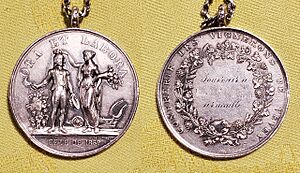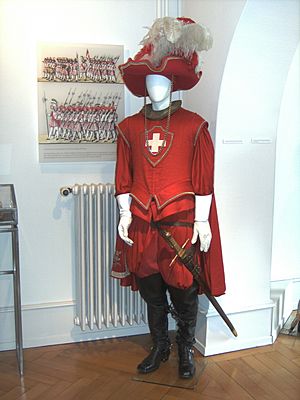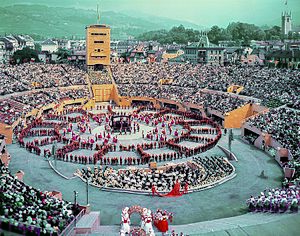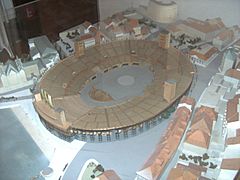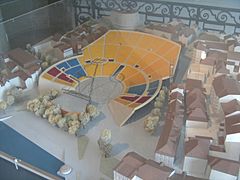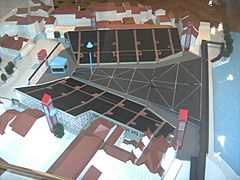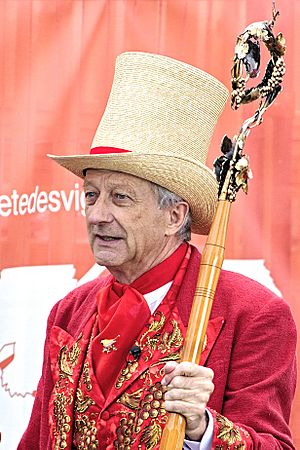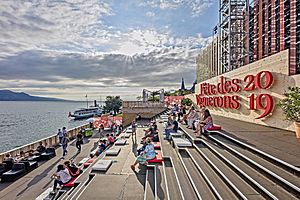Fête des Vignerons facts for kids
Quick facts for kids Fête des Vignerons |
|
|---|---|
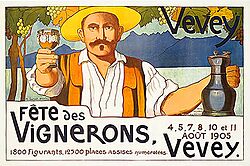
Fête des Vignerons poster, 1905
|
|
| Frequency | Once in a generation |
| Location(s) | Vevey, Switzerland |
| Inaugurated | 1797 |
| Most recent | July–August 2019 |
| Organised by | Confrérie des Vignerons |
| Winegrowers' Festival in Vevey | |
|---|---|
|
UNESCO Intangible Cultural Heritage
|
|
| Country | Switzerland |
| Reference | 01201 |
| Region | Europe and North America |
| Inscription history | |
| Inscription | 2016 (11th session) |
| List | Representative |
The Fête des Vignerons (which means 'Winegrowers' Festival' in French) is a very old and special festival. It happens in Vevey, a town in Switzerland, right by Lake Geneva.
This amazing festival is put on by the Confrérie des Vignerons, also known as the 'Brotherhood of Winegrowers'. They have been organizing it since 1797! The festival doesn't happen every year. Instead, it's held about once every 14 to 28 years, so it's truly a "once in a generation" event. The most recent festival took place in July and August 2019.
The Fête des Vignerons is a huge show that celebrates everything about making wine. The main performances happen in the marketplace in Vevey. There are also many other fun activities and parties all around the town. In 2016, this festival was added to UNESCO's list of intangible cultural heritage. This means it's recognized as an important tradition that should be protected.
The 2019 festival was so popular that famous travel guides like National Geographic and The New York Times recommended it as a top place to visit!
Contents
History of the Festival
How the Festival Started
The Fête des Vignerons began with parades organized by the Vevey Confrérie des Vignerons. This group was first called the Abbaye de l'Agriculture. It started small in 1647 but grew a lot. By 1776, almost a quarter of the men in Vevey were members!
The Confrérie wasn't for vineyard workers themselves. It was for landowners who hired workers to take care of their vineyards. A small group of experts from the Confrérie would visit the vineyards. They would check the quality of the work done by the winegrowers. This tradition continues even today.
Around 1770, the Confrérie decided to focus on rewarding good work. They wanted to encourage better winegrowing. The best vineyard workers would parade through Vevey with members of the Confrérie. Records show these parades happened as early as 1651.
These parades became more like a show. They included musicians and singers. In 1730, a boy dressed as Bacchus (the god of wine) rode on a wine barrel. From 1741, the parades happened every three years. In 1747, Ceres, the goddess of harvest, joined the parade. Other characters like Noah (the first winegrower) and mythical figures also became part of the show.
In 1791, a special ceremony was added. The best vineyard workers were crowned at the end of the parade. Six years later, on August 9, 1797, this crowning ceremony became a big staged show. Performers in costumes entered the Vevey marketplace. A stage and two thousand seats were set up. Dances and songs were performed there. The show was divided into four seasons: Spring, Summer, Autumn, and Winter. This was the beginning of the amazing celebrations we see today.
The 19th Century Festivals
After some difficult years, the festival returned in 1819. It took place on August 5 and 6. About 730 actors and performers took part in an arena with 2,000 seats. The festival celebrated Swiss traditions and patriotism. The famous Swiss song "Ranz des vaches" was sung for the first time. This festival was so big it needed a director for the dances and a musical director.
The third Fête des Vignerons happened in 1833. About 780 performers were in a 4,000-seat arena. New music was composed for this festival. The costumes were designed by a famous artist named Theophile Steinlen.
In 1851, the fourth festival took place. About 900 performers were in an 8,000-seat arena. For the first time, the "Ancient Swiss" troop marched in the parade. This group was originally meant to supervise the procession.
The festival continued to grow. In 1865, about 1,200 performers were in a 10,500-seat arena. It became more expensive to put on. The organizers had to ask the public for donations to help pay for it.
From August 5 to 9, 1889, the sixth Fête des Vignerons was held. This time, 1,379 actors and performers were in a 12,000-seat arena. The "Ranz des vaches" song was sung by a single singer for the first time. This showed how important the song was to the festival. It also connected Vevey to the nearby mountains and their traditions.
The 20th Century Festivals
The seventh Fête des Vignerons happened in 1905. This festival was special because the parade became less important than the main show. It was also the first time women and girls were allowed to perform. About 1,800 performers were in an arena with 12,500 seats.
From August 1 to 9, 1927, the eighth festival took place. About 2,000 performers were in a 14,000-seat arena. The arena was designed to look like a medieval city with walls and towers.
In 1955, the Fête des Vignerons was held from August 1 to 15. This was the first festival to have an international focus. Its capacity more than doubled compared to the previous one. About 3,850 performers took part in a 16,000-seat arena. This was also the first time night performances were organized.
From July 30 to August 14, 1977, the tenth Fête des Vignerons took place. About 4,250 performers were in a 15,776-seat arena. The stage was designed like a giant sundial. It had four main points showing the four seasons.
The 1999 Fête des Vignerons happened from July 29 to August 15. About 5,050 performers were in a 16,000-seat arena. The show featured a character named "Arlevin," who represented the crowned winemakers. On August 11, 1999, the audience got to see a total solar eclipse during the show!
- Models of amphitheatres from the second half of the 20th century
The 21st Century Festival
On December 1, 2016, the Fête des Vignerons was added to UNESCO's list of intangible cultural heritage. It was the first Swiss tradition to receive this special recognition.
The twelfth Fête des Vignerons was held from July 18 to August 11, 2019. About 6,000 actors and performers took part. This included nearly 1,000 singers! They performed in a huge arena with 20,000 seats. The "Ranz des vaches" song was sung by eleven traditional cow-herdsmen. This was different from recent festivals where a single singer performed it.
The 2019 show told the story of winegrowers' activities through the seasons. It was seen through the eyes of a little girl named "petite Julie." The show started during the grape harvest. Julie's grandfather taught her about grapevines and winemaking. She also met three funny "Doctors" who were experts on the festival. Julie's imagination turned reality into a magical dream world. A beautiful dragonfly joined her on her adventures.
See also
 In Spanish: Fête des Vignerons para niños
In Spanish: Fête des Vignerons para niños
- The Headsman: The Abbaye des Vignerons, a novel from 1833 by James Fenimore Cooper.



